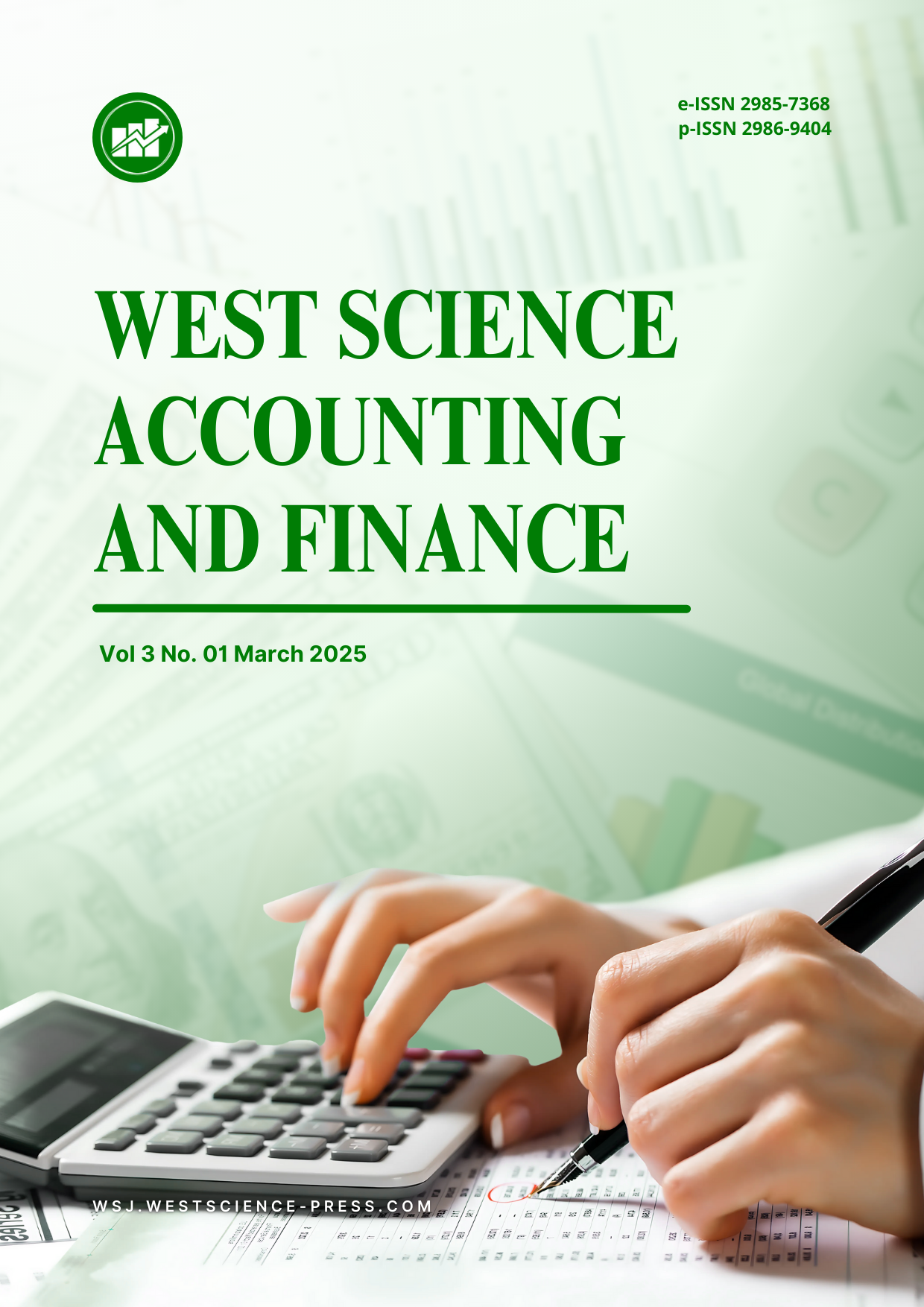The Bibliometric Study of The Criptocurrency Literature in Scopus Database
DOI:
https://doi.org/10.58812/wsaf.v3i01.1789Keywords:
Cryptocurrency, Blockchain, Bibliometric Analysis, VOSviewerAbstract
This study presents a comprehensive bibliometric analysis of cryptocurrency-related literature indexed in the Scopus database, aiming to map the intellectual landscape, identify key research trends, and highlight influential contributors in the field. Using VOSviewer as the primary analytical tool, the study examines keyword co-occurrence, temporal distribution, author collaboration networks, and international research partnerships. The findings indicate that the central focus of the literature remains on fundamental topics such as cryptocurrency, blockchain, and electronic money, while emerging trends show a growing integration of machine learning, forecasting, and sentiment analysis. Temporal mapping reveals a shift from infrastructure-oriented research to data-driven and interdisciplinary applications. Key authors and countries, including the United States, China, India, and the United Kingdom, play dominant roles in shaping the scholarly conversation. Despite the expanding scope of cryptocurrency research, gaps remain in areas such as sustainability, inclusivity, and ethical implications of AI applications. This study offers valuable insights for researchers, policymakers, and practitioners seeking to understand the evolution and future directions of cryptocurrency research.
References
[1] M. Milutinović, “Cryptocurrency,” Економика-Часопис за економску теорију и праксу и друштвена питања, no. 1, pp. 105–122, 2018.
[2] B. Zohuri, H. T. Nguyen, and M. Moghaddam, “What is the Cryptocurrency,” Is it a Threat to our Natl. Secur. Domest. Glob., pp. 1–14, 2022.
[3] I. G. A. Pernice and B. Scott, “Cryptocurrency,” Internet policy Rev., vol. 10, no. 2, 2021.
[4] U. Mukhopadhyay, A. Skjellum, O. Hambolu, J. Oakley, L. Yu, and R. Brooks, “A brief survey of cryptocurrency systems,” in 2016 14th annual conference on privacy, security and trust (PST), IEEE, 2016, pp. 745–752.
[5] F. Fang et al., “Cryptocurrency trading: a comprehensive survey,” Financ. Innov., vol. 8, no. 1, p. 13, 2022.
[6] E. Bouri, S. J. H. Shahzad, and D. Roubaud, “Co-explosivity in the cryptocurrency market,” Financ. Res. Lett., vol. 29, pp. 178–183, 2019.
[7] N. Donthu, S. Kumar, D. Mukherjee, N. Pandey, and W. M. Lim, “How to conduct a bibliometric analysis: An overview and guidelines,” J. Bus. Res., vol. 133, pp. 285–296, 2021.
[8] G. M. Caporale, L. Gil-Alana, and A. Plastun, “Persistence in the cryptocurrency market,” Res. Int. Bus. Financ., vol. 46, pp. 141–148, 2018.
[9] R. Farell, “An analysis of the cryptocurrency industry,” Whart. Res. Sch., vol. 130, pp. 1–23, 2015.
[10] V. A. Maese, A. W. Avery, B. A. Naftalis, S. P. Wink, and Y. D. Valdez, “Cryptocurrency: A primer,” Bank. Lj, vol. 133, p. 468, 2016.
[11] N. Gandal and H. Halaburda, “Competition in the cryptocurrency market,” Bank of Canada, 2014.
[12] Y. Liu, A. Tsyvinski, and X. Wu, “Common risk factors in cryptocurrency,” J. Finance, vol. 77, no. 2, pp. 1133–1177, 2022.
[13] Y. Liu and A. Tsyvinski, “Risks and returns of cryptocurrency,” Rev. Financ. Stud., vol. 34, no. 6, pp. 2689–2727, 2021.
[14] S. Corbet, D. J. Cumming, B. M. Lucey, M. Peat, and S. A. Vigne, “The destabilising effects of cryptocurrency cybercriminality,” Econ. Lett., vol. 191, p. 108741, 2020.
[15] B. M. Lucey, S. A. Vigne, L. Yarovaya, and Y. Wang, “The cryptocurrency uncertainty index,” Financ. Res. Lett., vol. 45, p. 102147, 2022.
[16] J. Liu and A. Serletis, “Volatility in the cryptocurrency market,” Open Econ. Rev., vol. 30, no. 4, pp. 779–811, 2019.
[17] A. ElBahrawy, L. Alessandretti, A. Kandler, R. Pastor-Satorras, and A. Baronchelli, “Evolutionary dynamics of the cryptocurrency market,” R. Soc. open Sci., vol. 4, no. 11, p. 170623, 2017.
[18] D. K. C. Lee, L. Guo, and Y. Wang, “Cryptocurrency: A new investment opportunity?,” J. Altern. Investments, vol. 20, no. 3, p. 16, 2018.
[19] M. Abramowicz, “Cryptocurrency-based law,” Ariz. L. Rev., vol. 58, p. 359, 2016.
[20] M. Bartoletti, S. Lande, A. Loddo, L. Pompianu, and S. Serusi, “Cryptocurrency scams: analysis and perspectives,” Ieee Access, vol. 9, pp. 148353–148373, 2021.
[21] M. Wątorek, S. Drożdż, J. Kwapień, L. Minati, P. Oświęcimka, and M. Stanuszek, “Multiscale characteristics of the emerging global cryptocurrency market,” Phys. Rep., vol. 901, pp. 1–82, 2021.
[22] E. Duffield and D. Diaz, “Dash: A privacycentric cryptocurrency.” No Publisher, 2015.
[23] C. Harwick, “Cryptocurrency and the problem of intermediation,” Indep. Rev., vol. 20, no. 4, pp. 569–588, 2016.
[24] P. Xia et al., “Characterizing cryptocurrency exchange scams,” Comput. Secur., vol. 98, p. 101993, 2020.
[25] M. Luo and S. Yu, “Financial reporting for cryptocurrency,” Rev. Account. Stud., vol. 29, no. 2, pp. 1707–1740, 2024.
[26] W. Zhang, P. Wang, X. Li, and D. Shen, “Some stylized facts of the cryptocurrency market,” Appl. Econ., vol. 50, no. 55, pp. 5950–5965, 2018.
[27] L. Ante, I. Fiedler, and E. Strehle, “The influence of stablecoin issuances on cryptocurrency markets,” Financ. Res. Lett., vol. 41, p. 101867, 2021.
[28] S. Demiralay and P. Golitsis, “On the dynamic equicorrelations in cryptocurrency market,” Q. Rev. Econ. Financ., vol. 80, pp. 524–533, 2021.
[29] V. Dyntu and O. Dykyi, “Cryptocurrency in the system of money laundering,” Balt. J. Econ. Stud., vol. 4, no. 5, pp. 75–81, 2018.
[30] P. P. Momtaz, “The pricing and performance of cryptocurrency,” Eur. J. Financ., vol. 27, no. 4–5, pp. 367–380, 2021.
[31] P. D. DeVries, “An analysis of cryptocurrency, bitcoin, and the future,” Int. J. Bus. Manag. Commer., vol. 1, no. 2, pp. 1–9, 2016.
Downloads
Published
Issue
Section
License
Copyright (c) 2025 Loso Judijanto

This work is licensed under a Creative Commons Attribution-ShareAlike 4.0 International License.
























 Instagram
Instagram 